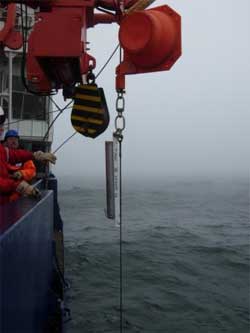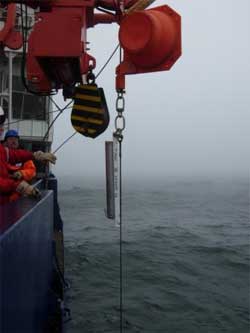 NARRAGANSETT, R.I. – September 12, 2012 – Pollutants from throughout the Northern Hemisphere often make their way through the air and water to the Arctic, where they can persist for decades and affect the health of the people and wildlife that live there. Now a University of Rhode Island oceanographer is collaborating with scientists at Harvard University and the Massachusetts Institute of Technology to better understand how and why various kinds of pollutants persist in the environment.
NARRAGANSETT, R.I. – September 12, 2012 – Pollutants from throughout the Northern Hemisphere often make their way through the air and water to the Arctic, where they can persist for decades and affect the health of the people and wildlife that live there. Now a University of Rhode Island oceanographer is collaborating with scientists at Harvard University and the Massachusetts Institute of Technology to better understand how and why various kinds of pollutants persist in the environment.
“The Arctic is a fascinating place,” said Rainer Lohmann, associate professor of chemical oceanography at the Graduate School of Oceanography. “It’s cold, so things degrade much slower. It’s in the Northern Hemisphere where more people live and where there are more pollutants. And its food web structure is long, so pollutants accumulate up the food chain into large marine mammals that people care about.”
Thanks to a $1 million grant from the National Science Foundation, Lohmann and his colleagues will study how older industrial pollutants like PCBs and DDT fare in the Arctic compared with what he calls “emerging contaminants.” The focus will be on new fluorinated compounds that have been used in non-stick pans, no-stain carpets and water repellent outdoor apparel.
Lohmann has collected water samples from the Arctic Ocean north of Alaska, Europe and Russia and deployed sampling devices east of Greenland and elsewhere that can detect the levels of various contaminants. His Harvard and MIT colleagues are creating atmospheric and ocean models that will track the transport of the pollutants.
“There are a lot of big questions that we hope to answer,” Lohmann said. “For instance, why are PCBs still around in such abundance 40 years after they were banned? As for the newer compounds, some of them have been banned as well, but it is unclear whether there is any evidence that the ban has had an effect.”
Working with three graduate students who will rotate among the three research institutions, the science team hopes to reproduce the current state of Arctic contamination and predict what will happen to the contaminants in the future.
The uncertain effects of global warming will make their job particularly difficult.
“If there is a lot less sea ice up there, that means there could be a greater movement of marine contaminants into the atmosphere, which could help clean the ocean,” explained Lohmann. “But less ice also means more phytoplankton blooms, which could absorb more pollutants from the air into the water.”
For marine mammals, the changing environmental conditions may mobilize their lipid reserves where pollutants are stored, making things even worse for already stressed animals.
“I’m afraid there are no good news scenarios for the polar bear,” Lohmann said.
Pictured above
Scientists deploy instruments to measure pollutants in the Arctic Ocean.
Photo submitted by professor, Rainer Lohmann

